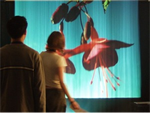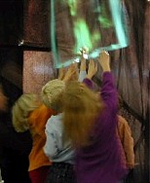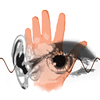 Previous
Previous
|
Students
Steve DiVerdi, Computer Science
MarkDavid Hosale, Media Arts & Tech
|
Faculty
Advisors
Tobias Hollerer, Computer Science
Ismo Rakkolainnen, Computer Science
Marcos Novak, Media Arts & Technology
|
Next
 |
| |
Abstract
The challenge of developing content for new media
is to develop content that exploits the medium to its fullest potential
even if its implied meaning sits outside current familiar models
of interaction. Although new media is rooted in past media, the
shift in methods of interacting that a new medium represents is
often not fully understood until much later in history (take for
example the invention of the mouse by Douglas Enggelbart in 1964,
nearly 20 years before it became a mainstream computer interface!).
The goal of the project is to exploit the potential of the FogScreen
through the intuitive interaction with virtual dynamic physical
phenomena. These physical phenomena include particle systems (large
numbers of what are effectively marbles that can be manipluated),
rigid body systems (smaller numbers of largere objects, such as
boxes, cylinders, tori, etc.), water surfaces, and smoke fields.
Coupled with various tracking technologies, the FogScreen facilitates
interaction with physical phenomena through direct interaction.
With the FogScreen users can manipulate content simply by placing
their hands on the screen. This differs from current interaction
techniques where the users must place their hands in front of the
screen (or somewhere else entirely). The FogScreen has a better
potential for emerging a user in a virtual environment by removing
the spatial disconnect commonly found in more conventional computer
interfaces.
The content of any medium is framed by the medium itself. As stated
earlier, the challenge is to fill this frame (i.e. exploit the medium).
New modes of interaction lead to new modes of navigation in virtual
environments. Several types of content modes should be developed
for the FogScreen, ranging from the literal to the abstract, in
order to fully explore its potential. Modes should be intuitive
to navigate, but may require some initial trials before a user can
successfully navigate a particular space. In the long term the FogScreen
will be able to provide a meaningful interface for virtual exploration,
performance and composition.
|
|


*Images courtesy of www.fogscreen.com |
|
|
|


